|
Family: Dacelonidae (dacelonid
kingfishers)
Life
> Eukaryotes >
Opisthokonta
> Metazoa (animals) >
Bilateria >
Deuterostomia > Chordata >
Craniata > Vertebrata (vertebrates) > Gnathostomata (jawed
vertebrates) > Teleostomi (teleost fish) > Osteichthyes (bony fish) > Class:
Sarcopterygii (lobe-finned
fish) > Stegocephalia (terrestrial
vertebrates) > Tetrapoda
(four-legged vertebrates) > Reptiliomorpha > Amniota >
Reptilia (reptiles) >
Romeriida > Diapsida > Archosauromorpha > Archosauria >
Dinosauria
(dinosaurs) > Saurischia > Theropoda (bipedal predatory dinosaurs) >
Coelurosauria > Maniraptora > Aves (birds) > Order: Coraciiformes
Species indigenous to southern Africa
|
Halcyon
albiventris (Brown-hooded kingfisher)
The Brown-hooded kingfisher is common in the eastern half of southern
Africa, mainly living in woodland habitats, as well as heavily wooded
gardens and parks. It has a broad and varied diet, eating a wide variety of
animals, rarely eating fish. Both sexes excavate the nest, which is a
burrow, normally dug into the walls of gullies. It lays 2-5, rarely 6 eggs,
which are incubated solely by the female, for about 14 days. Very little is
known about the young. It seems that they are fed mainly fed by the female,
and they are fed by their parents after fledging. |
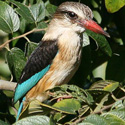 |
|
Halcyon
chelicuti (Striped kingfisher) The
Striped kingfisher is widespread in sub-Saharan Africa, occupying a wide
variety of open woodland and grassland habitats. Its diet mainly consists of
insects, especially grasshoppers, occasionally eating small vertebrates. It
usually nests in tree cavities, either natural or made by woodpeckers or
barbets. Here it lays 1-6 eggs, which are incubated by both sexes. The
chicks are cared for by both parents and sometimes a nest helper, who is
usually a non-breeding male, becoming fully independent soon after fledging. |
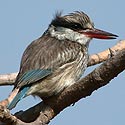 |
|
Halcyon
leucocephala (Grey-headed kingfisher, Grey-hooded kingfisher)
The Grey-headed kingfisher is common across sub-Saharan Africa, mainly
occurring in well developed woodland, often near rivers or streams. Its diet
mainly consists of insects, especially grasshoppers, occasionally eating
small vertebrates. It is an intra-African breeding migrant, arriving here
around April and leaving in the period from December-May. Both sexes
excavate the nest, which is a burrow consisting of a tunnel leading to a
nest chamber, dug into riverbanks, gullies, etc. It lays 3-4 eggs, which are
incubated by both sexes, for about 20 days. The eggs hatch into small, naked
chicks with black bills and brownish legs, who are cared for by both
parents. |
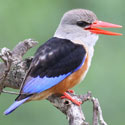 |
|
Halcyon
senegalensis (Woodland kingfisher) The
Woodland kingfisher is common across sub-Saharan Africa, occupying a wide
variety of woodland and savanna habitats. It is quite an adaptable hunter,
feeding mainly insects but also small vertebrates, such as fish, snakes and
even other birds! It is an intra-African migrant, arriving in southern
Africa around September-December, breeding then leaving for Central Africa
around March-April. It usually nests in tree cavities, either natural or
excavated by barbets or woodpeckers, laying 2-4 eggs incubated by both
sexes. The chicks grow rapidly, cared for by both parents, leaving the nest
at about 18-24 days old. They remain dependent on their parents for about 5
more weeks after fledging, after which they usually disperse. |
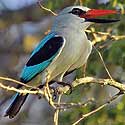 |
|
Halcyon senegaloides
(Mangrove kingfisher)
|
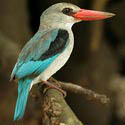 |
|
